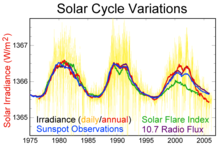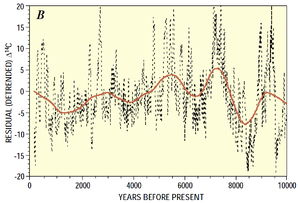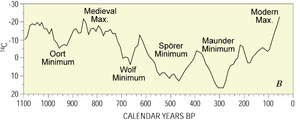This is an old revision of this page, as edited by SEWilco (talk | contribs) at 19:04, 24 February 2005 (→Changes in ultraviolet irradiance: rephrase and wikilink). The present address (URL) is a permanent link to this revision, which may differ significantly from the current revision.
Revision as of 19:04, 24 February 2005 by SEWilco (talk | contribs) (→Changes in ultraviolet irradiance: rephrase and wikilink)(diff) ← Previous revision | Latest revision (diff) | Newer revision → (diff)
Solar variation refers to fluctuation in the amount of energy emitted by the Sun. Small variations have been measured from satellites during recent decades. Of interest to climate scientists is whether these variations have a significant effect on the temperature of the earth's atmosphere.
The amount of solar radiation emitted at the surface does not change much (see solar constant) from an average value of 1366 W/m². The variations in total output are so slight (as a percentage of total output) that they remained at or below the threshold of detectability until the satellite era, although the small fraction in ultra-violet wavelengths varies by a few percent. Total solar output is now measured to vary (over the last two 11-year sunspot cycles) by less that 0.1% or about 1 W/m² peak-to-trough of the 11 year sunspot cycle. There are no direct measurements of the longer-term variation and interpretations of proxy measures of variations differ. Nonetheless, some theorise that solar variation is the primary cause of climate change.
Sunspots and Solar luminosity
Sunspots are relatively dark areas on the surface of the Sun and are thus cooler than its average surface. The number of sunspots correlates with the intensity of solar radiation. Since sunspots are dark it is natural to assume that more sunspots means less solar radiation. However the surrounding areas are brighter and the overall effect is that more sunspots means a brighter sun. The variation is small (of the order of 1 W/m² or 0.1% of the total) and was only established once satellite measurements of solar variation became available in the 1980s. Various studies have been made using sunspot number (for which records extend over hundreds of years) as a proxy for solar output (for which good records only extend for a few decades). Also, comparisons between ground instruments, high-altitude instruments, and instruments in orbit have been used to calibrate ground instruments. Researchers have combined present readings and factors to adjust historical data. Also used have been proxy data, such as measurements of cosmic ray isotopes to infer solar magnetic activity and thus the likely brightness.

Solar cycles
Solar cycles are cyclic changes in behavior of the Sun. Many possible patterns have been noticed.
- 11 years: Most obvious is a gradual increase and decrease of the number of sunspots over a period of about 11 years, called the Schwabe cycle. This seems to be due to a shedding of entangled magnetic fields. The Sun's surface is also the most active when there are more sunspots, although the luminosity does not change much due to an increase in bright spots (faculae).
- 22 years: Hale cycle. The magnetic field of the Sun reverses during each Schwabe cycle, so the magnetic poles return to the same state after two reversals.
- 88 years: Gleissberg cycle (70-100 years) is thought to be an amplitude modulation of the 11-year Schwabe Cycle (Sonnett and Finney, 1990).
- 200 years: Suess cycle.
- 2,000 years: Hallstadtzeit cycle.
- Other patterns have been detected:
- In carbon-14: 105, 131, 232, 385, 504, 805, 2,241 years (Damon and Sonnett, 1991).
- During the Upper Permian 240 million years ago, mineral layers created in the Castile Formation show cycles of 2,500 years.
Solar irradiance of Earth and its surface
Solar irradiance is the amount of sunlight which reaches the Earth. The equipment used might measure optical brightness, total radiation, or radiation in various frequencies. Historical estimates use various measurements and proxies.
There are two common meanings:
- the radiation reaching the upper atmosphere
- the radiation reaching some point within the atmosphere, including the surface.
Various gases within the atmosphere absorb some solar radiation at different wavelengths, and clouds and dust also affect it. Hence measurements above the atmosphere are needed to observe variations in solar output, within the confounding effects of changes to the atmosphere. Indeed, there is some evidence that sunshine at the Earth's surface has been decreasing in the last 50 years (see global dimming) possibly caused by increased atmospheric pollution, whilst over roughly the same timespan solar output has been nearly constant.
Solar interactions with Earth
There are several ways that solar variations may affect Earth. Some variations, such as changes in the size of the Sun, are presently only of interest in the field of astronomy.
Changes in total irradiance
- Overall brightness may change.
- The variation during recent cycles has been about 0.1%.
- Changes corresponding to solar changes with periods of 9-13, 18-25, and >100 years been measured in sea-surface temperatures.
- Since the Maunder Minimum, over the past 300 years there probably has been an increase of 0.1 to 0.6%, with climate models often using a 0.25% increase.
Changes in ultraviolet irradiance
- Ultraviolet irradiance (EUV) ranges widely through factors of 2 to 10 during a solar cycle.
- Energy changes in the UV wavelengths involved in production and loss of ozone have atmospheric effects.
- The 30 hPa pressure level has changed height in phase with solar activity during the last 4 solar cycles.
- UV irradiance increase causes higher ozone production, leading to stratospheric heating and to poleward displacements in the stratospheric and tropospheric wind systems.
- A proxy study estimates that UV increased by 3% since the Maunder Minimum.
Changes in the solar wind and the Sun's magnetic flux
- A more active solar wind and stronger magnetic field reduces the cosmic rays striking the Earth's atmosphere.
- Levels of C and Be show changes tied to solar activity.
- Cosmic ray ionization in the upper atmosphere does change, but significant effects are not obvious.
- As the solar coronal-source magnetic flux doubled during the past century, the cosmic-ray flux has decreased by about 15%.
- The Sun's total magnetic flux rose by a factor of 1.41 from 1964-1996 and by a factor of 2.3 since 1901.
Effects on clouds
- Cosmic rays may affect formation of clouds.
- 1983-1994 data from the International Cloud Climate Project (ISCCP) showed that global low cloud formation was highly correlated with cosmic ray flux.
- The Earth's albedo decreased by about 2.5% over 5 years during the recent solar cycle, as measured by lunar "Earthshine". Similar reduction was measured by satellites during the previous cycle.
- Mediterranean core study of plankton detected a solar-related 11 year cycle, and an increase 3.7 times larger between 1760 and 1950. A considerable reduction in cloud cover is proposed.
Other effects due to solar variation
Interaction of solar particles, the solar magnetic field, and the Earth's magnetic field, cause variations in the particle and electromagnetic fields at the surface of the planet. Extreme solar events can affect electrical devices. Weakening of the Sun's magnetic field is believed to increase the number of interstellar cosmic rays which reach Earth's atmosphere, altering the types of particles reaching the surface. It has been speculated that a change in cosmic rays could cause an increase in certain types of clouds, affecting Earth's albedo.
Carbon-14 production




The production of radiocarbon (Carbon-14: C) also is related to solar activity. Radiocarbon is produced in the upper atmosphere by bombardment of atmospheric nitrogen (N) with neutrons from outer space (cosmic rays). An increase in solar activity (more sunspots) is accompanied by an increase in the "solar wind," which is an outflow of ionized particles, mostly protons and electrons, from the sun. The solar wind reflects cosmic rays and reduces C production. Therefore, the C concentration of the atmosphere is lower during sunspot maxima and higher during sunspot minima. By measuring the captured C in wood and counting tree rings, production of radiocarbon relative to recent wood can be measured and dated. A reconstruction of the past 10,000 years shows that the C production was much higher during the mid-Holocene 7,000 years ago and decreased until 1,000 years ago.
Global warming
Some researchers have correlated solar variation with changes in the Earth's average temperature and climate - sometimes finding an effect, and sometimes not. When effects are found they have tended to be greater than can be explained by direct response to the change in radiative forcing from solar change, so some kind of feedback or amplification mechanism is required. See attribution of recent climate change for a discussion of attribution of causes of current global warming.
Research by Willie Soon and Sallie Baliunas presents evidence that variations in solar radiation produced the warming that "put the green in Greenland" and led to a "Little Ice Age". The IPCC's estimate of solar forcing since 1750 is available .
Solar variation in climate models

Climate models are computer simulations which are used to examine understanding of climate behavior. Some models use constant values for solar irradiance, while some include the heating effects of a variable Sun. A good simulation by GCMs of global mean temperature over the last 100 years requires both natural (solar; volcanic) and human (greenhouse gas) factors.
There is currently no clear agreement as to the likely magnitude of long-term (last hundred or more years) solar variation. The IPCC discuss this in section 6.11 of the TAR and show various results including Lean et al. (1995) . More recently Lean et al (GRL 2002, ) say:
- Our simulation suggests that secular changes in terrestrial proxies of solar activity (such as the 14C and 10Be cosmogenic isotopes and the aa geomagnetic index) can occur in the absence of long-term (i.e., secular) solar irradiance changes. ...this suggests that total solar irradiance may also lack significant secular trends. ...Solar radiative forcing of climate is reduced by a factor of 5 when the background component is omitted from historical reconstructions of total solar irradiance ...This suggest that general circulation model (GCM) simulations of twentieth century warming may overestimate the role of solar irradiance variability. ...There is, however, growing empirical evidence for the Sun's role in climate change on multiple time scales including the 11-year cycle ...Climate response to solar variability may involve amplification of climate modes which the GCMs do not typically include. ...In this way, long-term climate change may appear to track the amplitude of the solar activity cycles because the stochastic response increases with the cycle amplitude, not because there is an actual secular irradiance change.
History of study of solar variations
The longest recorded aspect of solar variations are changes in sunspots. Shortly after astronomers began using the telescope in 1609, sunspots and their motions were observed. Initial study was focused on their nature and behavior. Although the physical aspects of sunspots was not identified until the 1900s, observations continued. Study was hampered during the 1600s and 1700s due to the low number of sunspots during what is now recognized as an extended period of low solar activity, this event named the Maunder Minimum. By the 1800s records of their numbers began to show variations in their numbers. For details about sunspots see the main article: Sunspot
Around 1900 connections between solar variations and weather on Earth began to be explored. Challenges are shown in the efforts of Charles Greeley Abbot, assigned by the Smithsonian Astrophysical Observatory to detect changes in the radiation of the Sun. His team had to begin by inventing instruments to measure solar radiation. Later, when he was head of the SAO, it established a solar station at Calama, Chile to complement its data from Mount Wilson Observatory. He detected 27 harmonic periods within the 273-month Hale cycles, including 7, 13, and 39 month patterns. He looked for connections to weather by means such as matching opposing solar trends during a month to opposing temperature and precipitation trends in cities.
Statistical studies of solar activity with weather and climate were particularly popular until the 1980s, when publications blossomed with studies of weather fronts and global meteorological patterns. Photos from space and weather satellites emphasized the importance of clouds and weather fronts. Climate studies and weather forecasting have been enhanced by increasing use of climate models, beginning with simple computer simulations and replacing "solar constant" values with more detailed solar variation as computing power increased and understanding of weather processes improves.
See Also
References
- Template:Journal reference issue
- "The Sun and Climate". U.S. Geological Survey Fact Sheet 0095-00. February 21.
{{cite web}}: Check date values in:|date=and|year=/|date=mismatch (help) - "The Sun's role in Climate Changes" (PDF). Proc. of The International Conference on Global Warming and The Next Ice Age, 19-24 August, 2001, Halifax, Nova Scotia. February 21.
{{cite web}}: Check date values in:|date=and|year=/|date=mismatch (help) - Template:Journal reference issue
External links
- "Changing Sun, Changing Climate?". The Discovery of Global Warming. February 21.
{{cite web}}: Check date values in:|date=and|year=/|date=mismatch (help) - Gerrit Lohmann, Norel Rimbu, Mihai Dima (2004). Climate signature of solar irradiance variations: analysis of long-term instrumental, historical, and proxy data. International Journal of Climatology 24(8), 1045-1056 - Abstract: http://www.palmod.uni-bremen.de/~gerrit/abstractSolar.html
- Solar Climatic Effects (Recent Influence) – Summary. Center for the Study of Carbon Dioxide and Global Change. 19 March 2003. http://www.co2science.org/subject/s/summaries/solarrecin.htm
- S.K Solanski, M. Fligge (2001) Long-term changes in solar irradiance ESA SP-463, ESA Publications Division. http://www.astro.phys.ethz.ch/papers/fligge/solspa_2.pdf
- S.K. Solanki, M. Fligge (2000) Reconstruction of past solar irradiance Space Science Review 94, 127-138 http://www.astro.phys.ethz.ch/papers/fligge/solfli_rev.pdf
- George C. Reid (1995) The sun-climate question: Is there a real connection? Aeronomy Laboratory, NOAA/ERL, Boulder, Colorado. U.S. National Report to IUGG, 1991-1994 Rev. Geophys. Vol. 33 Suppl. http://www.agu.org/revgeophys/reid00/reid00.html